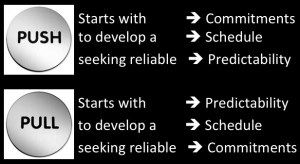T-shirt Sizing: Predictability with Pull Scheduling
Note: Post updated on 3/29/12 to correct titles on the three T-shirt size tables and to lighten the blue shade on the Medium T-shirt size row in these tables to make it easier to read.
“We do estimation very badly in the software field. Most of our estimates are more like wishes than realistic targets.”
– Robert L. Glass, Nov 2002 – Facts and Fallacies of Software Engineering“The best way to get a project done faster is to start sooner.”
– Jim Highsmith
 In earlier posts (here, here, and here), I commented briefly about moving away from upfront estimating and toward tracking and measuring “actual” metrics to complete work items, and using this data as a foundation for predictable scheduling and forecasting. Am I suggesting your software development team can’t achieve effective “predictable” scheduling using upfront estimating? No. But first, to be clear, I’m delineating upfront estimating activities from upfront analysis activities. The former is associated with predicting the number of calendar days (duration) to complete a work item and the actual hours (effort) expended on a work item. The latter is associated more with partitioning larger work items (epic, feature) into smaller ones (story, task) and determining relationships and dependencies between them to assess complexity or risk.1 The significance for decoupling these becomes apparent shortly. So, in your context, if teams haven’t achieved effective predictable scheduling using upfront estimating, I am suggesting it might be beneficial to approach project planning from what is likely a different perspective. I’m also suggesting that over time this different perspective may reduce planning effort.
In earlier posts (here, here, and here), I commented briefly about moving away from upfront estimating and toward tracking and measuring “actual” metrics to complete work items, and using this data as a foundation for predictable scheduling and forecasting. Am I suggesting your software development team can’t achieve effective “predictable” scheduling using upfront estimating? No. But first, to be clear, I’m delineating upfront estimating activities from upfront analysis activities. The former is associated with predicting the number of calendar days (duration) to complete a work item and the actual hours (effort) expended on a work item. The latter is associated more with partitioning larger work items (epic, feature) into smaller ones (story, task) and determining relationships and dependencies between them to assess complexity or risk.1 The significance for decoupling these becomes apparent shortly. So, in your context, if teams haven’t achieved effective predictable scheduling using upfront estimating, I am suggesting it might be beneficial to approach project planning from what is likely a different perspective. I’m also suggesting that over time this different perspective may reduce planning effort.
As an example, I’ll focus on one of the “actual” measurements my past teams collected, in this case Lead times for “story” work items, and discuss how we used this data to derive a very predictable range of “T-shirt” sizes. This range helped us predictably manage story level work items thru our workflow, and enabled us to identify issues earlier as they emerged for those needing alternative (special) processing or management. Before moving to how and what we did and the benefits obtained, I’ll briefly provide context for why we shifted perspective, which may reveal some insights for benefit in your environment.
Earlier Times in a Nutshell
Our development teams were well into implementing agile processes, and demonstrated visible improvements in several areas related to technical practices and our ability to deliver more frequently. However, we continually missed “commitments” for the number of stories to be completed in a sprint whether it was two weeks or 30 days. We were unsuccessful at effectively predicting duration or effort for completing stories using upfront estimating techniques that we had tried including variations of planning poker with ideal days, points, hours, Fibonacci sequences, etc. I won’t go into consequences of these estimating efforts here, but will highlight a key observation made during efforts to mitigate these costs that led to shifting our planning perspective.
As the mid-sprint approached and we saw our commitment at risk, at one point a team decided to assertively reduce (“de-commit”) work items (stories in this case) in their “Doing” state, moving them back to ToDo or to the story backlog. Again and again, when we did this in a sprint, stories remaining in the Doing state would get completed quickly, and then we’d “whip back” the other way and re-pull stories before the sprint end. After of a few of these “herky-jerky” sprints, we did something different and shifted to a “pull-scheduling” perspective.
Push vs Pull Scheduling?
 This image is my summary derived from sources contrasting push and pull scheduling systems.2 Push scheduling starts with obtaining commitments to upfront estimates of duration and effort, then develops a schedule based on these estimates and seeks predictable outcomes by attempting to adhere to the developed schedule. Pull scheduling starts with obtaining predictability of upfront (measured) capabilities and known constraints, then develops a schedule based on these capabilities and constraints and seeks to achieve commitments to the developed schedule. Is this distinction a bit too intangible for you? (more…)
This image is my summary derived from sources contrasting push and pull scheduling systems.2 Push scheduling starts with obtaining commitments to upfront estimates of duration and effort, then develops a schedule based on these estimates and seeks predictable outcomes by attempting to adhere to the developed schedule. Pull scheduling starts with obtaining predictability of upfront (measured) capabilities and known constraints, then develops a schedule based on these capabilities and constraints and seeks to achieve commitments to the developed schedule. Is this distinction a bit too intangible for you? (more…)

 In 2003, Mary Poppendieck published a paper titled “Lean Development and the Predictability Paradox.” The lean principles found in this paper appear in a refined and expanded form in Mary and Tom Poppendieck’s book “Lean Software Development: An Agile Toolkit” (2003). However, unless I missed it, the Predictability Paradox, neither as a term or concept, appears explicitly in this book. But, the concept definitely resurfaced in their following book, “Implementing Lean Software Development: From Concept to Cash” (2006), although relabeled as a chapter sub-heading “Myth: Predictions Create Predictability.”
In 2003, Mary Poppendieck published a paper titled “Lean Development and the Predictability Paradox.” The lean principles found in this paper appear in a refined and expanded form in Mary and Tom Poppendieck’s book “Lean Software Development: An Agile Toolkit” (2003). However, unless I missed it, the Predictability Paradox, neither as a term or concept, appears explicitly in this book. But, the concept definitely resurfaced in their following book, “Implementing Lean Software Development: From Concept to Cash” (2006), although relabeled as a chapter sub-heading “Myth: Predictions Create Predictability.” Reflecting on the last ten years of my own experience working on projects, early on, I saw mostly “traditional project management.” That is, project management that places greater emphasis on planning upfront, and as a whole, a greater proportion of the total project planning is done very early in the project, and seeks to provide predictability of activities over longer planning horizons. Other terms I’ve heard for this project management style are “predictive” or “sequential (gateway) delivery.” In more recent years, however, my experience has been to see “iterative and incremental” approaches. Again, that is, project management that places less emphasis on planning upfront, and as a whole, a greater proportion of the total project planning is done in small amounts iteratively across the project, and seeks to provide predictability of activities only over shorter planning horizons. Other terms I’ve heard for this project management style are “emergent” and “incremental delivery.”
Reflecting on the last ten years of my own experience working on projects, early on, I saw mostly “traditional project management.” That is, project management that places greater emphasis on planning upfront, and as a whole, a greater proportion of the total project planning is done very early in the project, and seeks to provide predictability of activities over longer planning horizons. Other terms I’ve heard for this project management style are “predictive” or “sequential (gateway) delivery.” In more recent years, however, my experience has been to see “iterative and incremental” approaches. Again, that is, project management that places less emphasis on planning upfront, and as a whole, a greater proportion of the total project planning is done in small amounts iteratively across the project, and seeks to provide predictability of activities only over shorter planning horizons. Other terms I’ve heard for this project management style are “emergent” and “incremental delivery.”